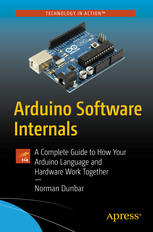The code below, somewhere, shows how to measure the temperature of the ATmega328 microcontroller built in to numerous Arduino boards. You can find all the gory details in my new book Arduino Software Internals available from Apress, Amazon and good bookshops everywhere.

A complete guide to how the Arduino Language works, and how it makes the hardware work.
Apress.com: https://www.apress.com/gb/book/9781484257890
Amazon.co.uk: https://www.amazon.co.uk/Arduino-Software-Internals-Complete-Language/dp/1484257898/
The Warning
Do not use this code if your Arduino has the AREF pin connected to any voltage source. When you enable the 1.1v bandgap voltage as the ADC reference, it goes Bzzzt! And all the magic blue smoke gets out! The only thing connected to AREF should be a 100nF capacitor, to ground. (Already built in on Arduino boards.)
The Listing
/*
* ARDIUNO - measure the internal temperature of the
* AVR ATmega328P using the ADC internal temperature
* input. See the data sheet for details.
*
* (C) Norman Dunbar, July 21 2018.
*
* This code is in the public domain - use it and abuse
* it as you wish! It is based, but not copied, from
* an Atmel example found at:
*
* https://microchipdeveloper.com/8avr:avradc
*
*/
void setup() {
// Initialise the ADC to use the
// internal 1.1V reference voltage.
ADMUX = (1 << REFS0) | (1 << REFS1);
// Use the ADC multiplexer input
// number 8, the temperature sensor.
ADMUX |= (1 << MUX3);
// Slow the ADC clock down to 125 KHz
// by dividing by 128. Assumes that the
// standard Arduino 16 MHz clock is in use.
ADCSRA = (1 << ADPS2) | (1 << ADPS1) | (1 << ADPS0);
// Non-standard 8MHz clock in use.
//ADCSRA = (1 << ADPS2) | (1 << ADPS1) | (0 << ADPS0);
// Enable the ADC and discard the first reading as
// it is always 351 on my device.
ADCSRA |= (1 << ADEN) | (1 << ADSC);
(void)readADC();
// Use the Serial monitor for output.
Serial.begin(9600);
Serial.println("Arduino Internal Temperature");
}
// Read the ADC result from the most recent conversion and
// start another before ruturning the current reading.
uint16_t readADC() {
// Make sure the most recent ADC read is complete.
while ((ADCSRA & (1<<ADSC))) {
; // Just wait for ADC to finish.
}
uint16_t result = ADCW;
// Initiate another reading.
ADCSRA |= (1 << ADSC);
return result;
}
//-----------------------------------------------------------------
// There are many ways, it seems, to calculate the degrees C from
// the ADC. Read the chapter on the ADC to find out where they come
// from. Here are some:
//
// ADC - some random offset;
// (ADC - 247)/1.22;
// ADC - 273;
// (((ADC - (273 - 100 - TS_OFFSET)) * 128) / TS_GAIN) + 25.
// (ADC - 324.31) / 1.22
//
// I'm using the last one, as it's the one closest to my actual
// temperature measurements.
//-----------------------------------------------------------------
void loop() {
// Running average of the ADC Readings for
// better accuracy.
uint32_t ADCTotal = 0;
float ADCAverage = 0.0;
uint16_t ADCReading = readADC();
for (uint8_t x = 1; x < 101; x++) {
ADCTotal += ADCReading;
ADCAverage = (float)ADCTotal / (float)x;
// Uncomment if you want a running commentary!
/*
Serial.print("ADC = ");
Serial.print(ADCReading);
Serial.print(" ");
Serial.print("ADCTotal = ");
Serial.print(ADCTotal);
Serial.print(" ");
Serial.print("ADCAverage = ");
Serial.println(ADCAverage);
*/
ADCReading = readADC();
}
// Print the ADC temperature.
float degreesC = (ADCAverage - 324.31) / 1.22;
Serial.print(degreesC);
Serial.print("C, ");
// Convert to Fahrenheit. C * 1.8 + 32.
Serial.print(degreesC * 1.8 + 32);
Serial.println("F.");
// Delay a second more between readings.
delay(1000);
}